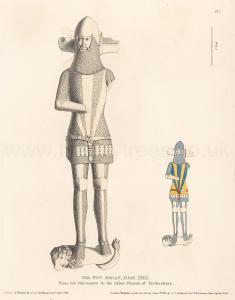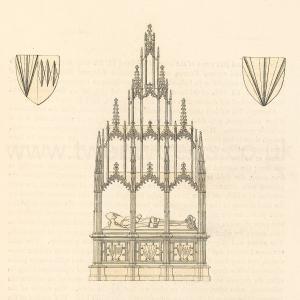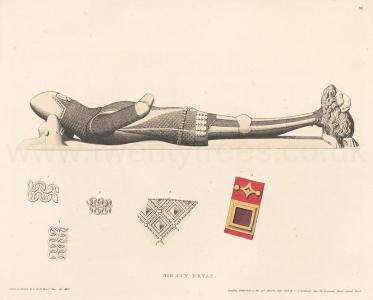Effigy of Sir Guy Bryan
Effigy of Sir Guy Bryan is in Monumental Effigies of Great Britain.
DURING the reigns of Edward III and Richard II no one appears to have been more actively or variously engaged than Sir Guy Bryan. He first presents himself to notice, 23rd Edward III. 1349, at the Battle of Calais, in which he bore the king's standard, when tor his gallant carriage with that trust he had granted him two hundred marks per annum, tor life, and, some time after, farther rewards. In 1354, he was one of the Embassadors sent with Henry, duke of Lancaster, to Rome. The year following in an expedition with the king against the French, he was made a Banneret. In 1359 he was again active in the French wars, and, two years after, revisited Rome on important business. In 1369 and 1370 he was Admiral of the king's fleet against France. Forty-fifth of Edward III. 1371, he was employed in the Scotish wars, and about this time received, as a reward for his important services, the Order of the Garter.
In the 1st and 2nd years of the reign of Richard II. Sir Guy Bryan served both by sea and land against France, and accompanied Edmund Mortimer, Earl of March, in his expedition to Ireland. He had summons to Parliament from 24th of Edward III. till 13th of Richard II. and departed this life on Wednesday, next after the feast of the Assumption of the Blessed Virgin, 14th Richard II. 1390.
Although this subject suffers considerably in its appearance, from the mutilations it has undergone, yet, from the richness and peculiarities of the armour, it is a valuable specimen. It is executed in stone, and has been painted, gilt, and silvered, though there is but little of this now remaining. Sir Guy Bryan appears to have been represented in the act of drawing his sword, an action not common on monuments at so late a period: on his head is the basinet, the camail attached to it by a red lace; the surcoat is charged with the arms of Bryan, or, three piles meeting in base azure, the field is diapered with a white raised composition; the piles are painted with ultramarine, and have been beautifully diapered with white, the only remains of which are to be traced under the right arm. The arms are covered by the mail sleeves of the haubergeon, the lower part only from the elbow defended with plate: on the upper, upon the mail, are singular appearances—a number of iron pegs placed in regular order, enclosing a space, in form and extent the same on both arms; for what purpose they were placed there, it is not easy to conjecture. The sword and dagger are broken away, as are also the gauntlets. The mail chausses covering the legs seldom appear after plate-armour had been so long introduced, and they have here singular additions, being strengthened with narrow plates above and below the genouillieres, each plate having, distributed equidistant along its sides, six pegs of wood, the purpose of these, or why they were of an extraneous substance, is as unaccountable as what we find on the arms. The whole of the armour, plate and mail, has been once covered with silver leaf. The mailles of the camail, haubergeon, and chausses, are of different sizes, and formed with a white impressed composition, as on the surcoat. The crest upon the helmet under the head is too much mutilated to determine what it is, but most resembles a griffin's head. We should have expected a bugle-horn for the crest. Sir William Bryan, son of Sir Guy, bearing this on his brass in Seale Church, Kent. The architectural part of the monument is extremely light and elegant, and it has on that account severely suffered; for many of the shafts, which supported this delicate fabric, are lost, and a great number of those that remain are out of their perpendiculars in all directions. As far as there were authorities remaining, a restoration has been made in the etching, which represents the monument nearly in its original state. The arms on the base are in the centre, and on each side. The wife of Sir Guy Bryan, being Elizabeth, daughter of William de Montacute, Earl of Salisbury.
Details.—Plate 2. Fig. 1, 2, 3, mailles of the camail, haubergeon, and chausses, the same size as the originals. 4. Raised diapering on the surcoat. 5. Part of the girdle.


